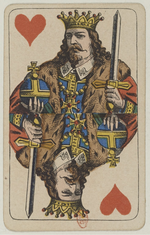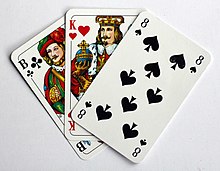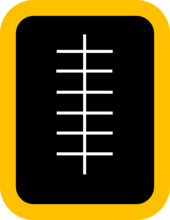
Contract bridge, or simply bridge, is a trick-taking card game using a standard 52-card deck. In its basic format, it is played by four players in two competing partnerships, with partners sitting opposite each other around a table. Millions of people play bridge worldwide in clubs, tournaments, online and with friends at home, making it one of the world's most popular card games, particularly among seniors. The World Bridge Federation (WBF) is the governing body for international competitive bridge, with numerous other bodies governing it at the regional level.

Omaha hold 'em is a community card poker game similar to Texas hold 'em, where each player is dealt four cards and must make their best hand using exactly two of them, plus exactly three of the five community cards. The exact origin of the game is unknown, but casino executive Robert Turner first brought Omaha into a casino setting when he introduced the game to Bill Boyd, who offered it as a game at the Las Vegas Golden Nugget Casino. Omaha uses a 52-card French deck. Omaha hold 'em 8-or-better is the "O" game featured in H.O.R.S.E.
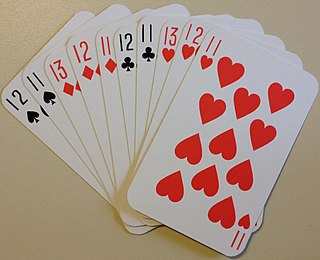
500 or Five Hundred is a trick-taking game developed in the United States from Euchre. Euchre was extended to a 10 card game with bidding and a Misère contract similar to Russian Preference, producing a cutthroat three-player game like Preference and a four-player game played in partnerships like Whist which is the most popular modern form, although with special packs it can be played by up to six players.

Black lady is an American card game of the hearts group for three to six players and the most popular of the group. It emerged in the early 20th century as an elaboration of hearts and was initially also called discard hearts. It is named after its highest penalty card, the queen of spades or "black lady". It is a trick-avoidance game in which the aim is to avoid taking tricks containing hearts or the black lady. American author and leading bridge exponent, Ely Culbertson, describes it as "essentially hearts with the addition of the queen of spades as a minus card, counting thirteen" and goes on to say that "black lady and its elaborations have completely overshadowed the original hearts in popularity".

Skat, historically Scat, is a three-player trick-taking card game of the ace–ten family, devised around 1810 in Altenburg in the Duchy of Saxe-Gotha-Altenburg. It is the national game of Germany and, along with Doppelkopf, it is the most popular card game in Germany and Silesia and one of the most popular in the rest of Poland. A variant of 19th-century Skat was once popular in the US. John McLeod considers it one of the best and most interesting card games for three players, and Kelbet described it as "the king of German card games." The German Skat Association assess that it is played by around 25 million Germans – more than play football.

Sheng ji is a family of point-based, trick-taking card games played in China and in Chinese immigrant communities. They have a dynamic trump, i.e., which cards are trump changes every round. As these games are played over a wide area with no standardization, rules vary widely from region to region.

Tiến lên is a shedding-type card game originating in Vietnam. It may be considered Vietnam's national card game, and is common in communities where Vietnamese migration has occoured. It is also played in the United States, sometimes under the names Viet Cong, VC, Thirteen, Killer, or 2’s.
Zar Points (ZP) is a statistically derived method for evaluating contract bridge hands developed by Zar Petkov. The statistical research Petkov conducted in the areas of hand evaluation and bidding is useful to bridge players, regardless of their bidding or hand evaluation system. The research showed that the Milton Work point count method, even when adjusted for distribution, is not sufficiently accurate in evaluating all hands. As a result, players often make incorrect or sub-optimal bids. Zar Points are designed to take many additional factors into consideration by assigning points to each factor based on statistical weight. While most of these factors are already implicitly taken into account by experienced players, Zar Points provides a quantitative method that allows them to be incorporated into bidding.
These terms are used in contract bridge, using duplicate or rubber scoring. Some of them are also used in whist, bid whist, the obsolete game auction bridge, and other trick-taking games. This glossary supplements the Glossary of card game terms.
Two-ten-jack is a Japanese trick-taking card game for two players that takes its name from the three highest-scoring cards in the game: the 2, 10 and Jack in three different suits.

Konter a Matt, Kontra a Matt or Konter a Midd is a Luxembourgish trick-taking card game played by four players. The game is popular enough to have been televised on RTL, Luxembourg's leading TV station and for tournaments to be organised. Konter a Matt is one of a family of similar games, known as the Couillon Group, played in the Benelux area. Other games in the family include the Belgian game of Couillon, known as Kwajongen in Flemish areas and Kujong in Luxembourg, the Dutch game of Troeven and the Belgian games of Brûte and Gamelle.

Gong Zhu (拱猪) is a Chinese four-player trick-taking card game that is similar to Black Lady, the leading member of the Hearts family. However, it differs in that it assigns quite different point values to cards. The objective of the game is to score positive points and avoid penalty points. Gong Zhu means: Push Out the Pig, for "pig" is the name given to the Q♠.

Bräus is an old Swedish card game from the island of Gotland that differs from all others in that not all cards are actually playable. The game is descended from the oldest known card game in Europe, Karnöffel, a fact testified by its unusual card ranking and lack of a uniform trump suit.
Maw, formerly also mawe, was a Scottish card game for two players, popularised by James I, which is ancestral to the Irish national game of Twenty-five as well as the Canadian game of Forty-fives. Maw appears to be the same as five cards, a game described by Charles Cotton in the 17th century. The game disappeared from the literature after the period of the English Commonwealth, only to emerge in Ireland in the 19th century in new forms for two or more players and known as five and ten, spoil five and forty-five. These new variants are still played today, the latter has evolved into the Canadian game of forty-fives.

Knüffeln is a very old trick-taking card game for four players, playing in pairs, that is still played in North Germany. Once considered the national game of Frisia, Knüffeln is a descendant of Karnöffel, the oldest identifiable European card game in the history of playing cards with a continuous tradition of play down to the present day.
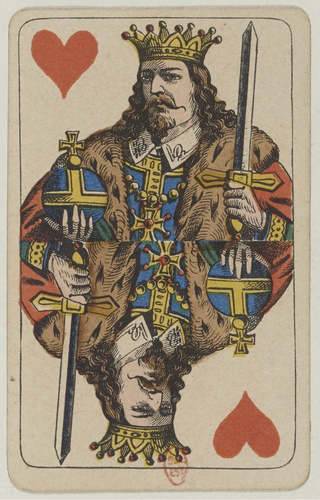
Brus is a four-hand card game of German descent that was once played in Denmark and Estonia. The game is descended from the oldest known card game in Europe, Karnöffel, a fact testified by its unusual card ranking and lack of a uniform trump suit.

Drużbart or Druzbart is an extinct Polish card game of the Bruus family. The game is descended from the oldest known card game in Europe, Karnöffel, a fact testified by its unusual card ranking and lack of a uniform trump suit.

Brús is a traditional Icelandic card game for four-players using French-suited cards. It is descended via German Brusbart from Karnöffel, Europe's oldest known card game.
Voormsi or Vorms is an old, Greenlandic, trick-taking card game of the Brusbart family designed for four players.
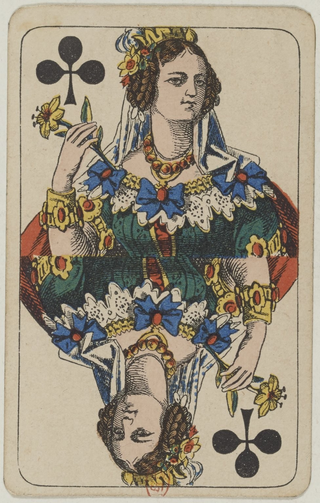
Skærvindsel is a Danish card game for four players that is a member of the Schafkopf family. Today it is mostly played in Jutland and is therefore often spelled Sjervinsel, but was previously widespread throughout Denmark. It was the first Danish game where the winner of the auction, the declarer, could choose a partner by calling an Ace. This principle has since been transferred to Call-Ace Whist (Esmakkerwhist).
